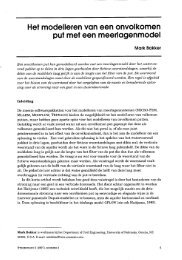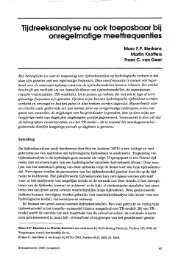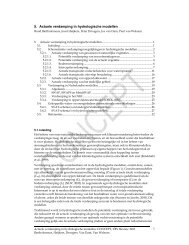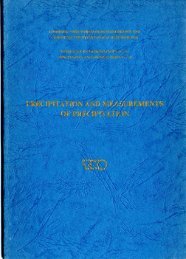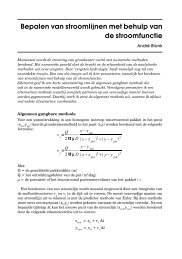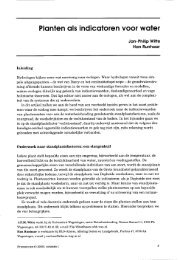Hydro-ecological relations in the Delta Waters
Hydro-ecological relations in the Delta Waters
Hydro-ecological relations in the Delta Waters
You also want an ePaper? Increase the reach of your titles
YUMPU automatically turns print PDFs into web optimized ePapers that Google loves.
Crucial here is <strong>the</strong> presence of extensive, protected shallows.<br />
Manageability of fish stocka should be lrentral to policy. Simply<br />
grant<strong>in</strong>g fish<strong>in</strong>g rights to anglers and fishermen, frustrate<br />
atzeqts to combat eutropkieation directly by means of active<br />
biological oiutagEment. Suceess is conditional on <strong>the</strong> management of<br />
fish stocks be<strong>in</strong>g <strong>in</strong>cgrporated <strong>in</strong>to water quality management.<br />
Salwte* entraphication <strong>in</strong> different frotn freshwater wtrophication,<br />
althongk closed, stagnant salt waters also have a greater<br />
susceptibility to eutrophication. One of <strong>the</strong> ma<strong>in</strong> differences is that<br />
<strong>in</strong> <strong>the</strong> case of salt water often nitrogen is <strong>the</strong> limit<strong>in</strong>g factor and<br />
nitrification is <strong>the</strong> key process. In response to this <strong>the</strong> Eollow<strong>in</strong>g<br />
managewant measures can be taken:<br />
- Excessive levels of nutrients <strong>in</strong> stagnant, sal<strong>in</strong>e systems are<br />
chiefly regional <strong>in</strong> orig<strong>in</strong>. In p~<strong>in</strong>eiple this provides scppe f ~ r<br />
gear<strong>in</strong>g nlltrient levels to <strong>the</strong> <strong>in</strong>dividual eapacity of a system. At<br />
its present level, <strong>the</strong> channell<strong>in</strong>g of nutrient-rich polder water<br />
<strong>in</strong>to <strong>the</strong> tidal systems does not lead to undesirable affects<br />
associated with wtmphicat-lon. The channell<strong>in</strong>g to ttre Ea6tern<br />
Scheldt of <strong>the</strong> polder water currently teleased <strong>in</strong>to <strong>the</strong> Veerse<br />
Wer, for example, i4 even expected to hr<strong>in</strong>g about a slighr rise <strong>in</strong><br />
productivity. The ma<strong>in</strong> objective, <strong>in</strong>cidentaliy, cont<strong>in</strong>ues to be <strong>the</strong><br />
improvement af polder water quality, not <strong>in</strong> <strong>the</strong> Least because of<br />
present pollution levels;<br />
- Besides adaptirrg nutrient levels to <strong>the</strong> system, it is necessary to<br />
create sufficient scope for <strong>in</strong>term<strong>in</strong>gl<strong>in</strong>g with salt tidal waters if<br />
stagnant, sal<strong>in</strong>e systems are to develop. Besides <strong>the</strong> significance<br />
of sal<strong>in</strong>ity as euch aa m <strong>ecological</strong> determ<strong>in</strong>ant, this approach<br />
permits regulation of <strong>the</strong> nutrient balance. Surplus nutrients and<br />
organic matter ean be &ra<strong>in</strong>ed<br />
off and <strong>the</strong> likelihood of<br />
stratification can be reduced. That this latter phenomenon is<br />
rmportant is illustrated by <strong>the</strong> Veerse Meer. where srratitiaatien<br />
has been Eamd to exacerbate <strong>the</strong> current prablenns of<br />
eutropllication;





